Tahquitz Plaza - 600-700 East Tahquitz Canyon Way SUCCESS
Tahquitz Plaza was constructed in two phases with Tahquitz Plaza I (at 600 and 650 East Tahquitz Canyon Way) designed by Kaptur-Lapham & Associates built in 1974 and Tahquitz Plaza II (at 700 and 750 East Tahquitz Canyon Way) designed by Hugh M. Kaptur, A.I.A. built in 1977. Tahquitz Plaza is an elegantly sited complex of modernist buildings located on one of the city’s major thoroughfares. The two “duplex” buildings house 32,000 square feet of office space. The architecture of the complex has been effusively described as “pueblo-influenced romantic form-giving.” Architect Hugh Kaptur designed many prominent modernist buildings including the Steve McQueen Residence on Southridge.
On October 18, 2019 PSPF honorary board member Hugh Kaptur and PSPF advisor Susan Secoy Jensen were recognized for their preservation efforts on Kaptur Plaza with a 2019 Preservation Design Award for Restoration by the California Preservation Foundation. Award recipients were selected by a jury of top professionals in the fields of architecture, engineering, planning, and history, as well as renowned architecture critics and journalists. In making their decision the jury made note not only of the workmanship, but of the tremendous community involvement, stating, “this exemplifies a distinct moment in architectural time…The community rallied to save it, and it’s great that people in Palm Springs are really putting their money where their mouth is, preserving their heritage.” To read more click here.
By March of 2018, there were several successful businesses occupying Tahquitz Plaza (renamed Kaptur Plaza) including the locally popular Koffi coffee shop. On their website, Palm Springs Koffi Central informs customers that, “We are located next to the Convention Center and surrounding hotels in Kaptur Plaza, a Class 1 historic property designed by master architect Hugh Kaptur and constructed in the mid-1970s.”
By January of 2017 the rehabilitation of the exterior of the Tahquitz Plaza complex was largely completed under the competent supervision of preservation architect and PSPF advisor Susan Secoy Jensen and architect Hugh Kaptur. As the Tahquitz Plaza complex had come extremely close to demolition, the stunning historic preservation result is a testament to the continuing relevance of aggressive and proactive preservation advocacy in Palm Springs.
In October of 2016 work on the exterior of the Tahquitz Plaza complex had started in earnest.
On April 10, 2016 PSPF was informed that a rehabilitation plan for the exterior repair of the entire Tahquitz Plaza complex had been prepared by preservation architect and PSPF advisor Susan Secoy-Jensen and architect Hugh Kaptur.
On December 2, 2015 the Palm Springs city council voted unanimously (5-0) to approve the Class 1 Historic Site designation of Tahquitz Plaza. Making compelling public comment in support of the nomination were PSPF board members Erik Rosenow, Steven Price, Tracy Beckmann and honorary PSPF board member and architect Hugh Kaptur. Also making persuasive public comment in support of the nomination were Peter Moruzzi (PSModCom) and Cory Alder (Nexus). Dozens of PSPF members sent emails to the city of Palm Springs in support of the Tahquitz Plaza designation.
On November 30, 2015 Nexus, the Palm Springs Preservation Foundation and the Palm Springs Modern Committee issued a press release announcing Nexus’ support of the Class 1 Historic Site designation of the entire Tahquitz Plaza complex and Nexus’ promise commitment to do a rehabilitation of the complex in accordance with Department of Interior standards. To read the press release click here. To read the Memorandum of Understanding between Nexus, PSPF and PSModCom click here.
On November 23, 2015 PSPF board members Erik Rosenow, Steven Price, Gary Johns and PSPF advisor Susan Secoy Jensen and PSModCom representatives Peter Moruzzi, Chris Menrad and Nickie McLaughlin met with senior representatives of Nexus (the owner of Tahquitz Plaza) to discuss various issues surrounding Tahquitz Plaza. The ensuing discussion between PSPF, PSModCom and Nexus representatives revealed many areas of consensus.
On October 13, 2015 the Palm Springs Historic Site Preservation Board (HSPB) unanimously recommended approval of the Tahquitz Plaza Class 1 Historic Site nomination to the city council. Making public comment in support of the Class 1 designation were PSPF board members Ron and Barbara Marshall and architect Hugh Kaptur. Just minutes after the HSPB vote, PSPF submitted a letter to the city manager asking him to schedule the city council hearing on Tahquitz Plaza for December 2, 2015. To read the PSPF letter click here.
On September 23, 2015 the Building Code Appeals Board met again to hear the PSPF appeal (submitted on June 1, 2015) of the demolition permit drawn by O&M HR (Nexus Development) for Tahquitz Plaza. Despite expressing reservations about denying the appeal, the board members could find no improper action on the part of the city in issuing the demolition permit and ultimately voted to deny the appeal.
On September 6, 2015 the city’s Historic Site Preservation Board met to discuss the Tahquitz Plaza Class 1 Historic Site nomination. PSPF board members Erik Rosenow and Tracy Beckmann and PSPF members David Keens and Danny Heller made public comment in support of the nomination. Enthusiastic comments in support of the nomination were also made by PSModCom representatives. Due to irregularities in the Tahquitz Plaza site visits, the Tahquitz Plaza nomination was “continued” until the October HSPB meeting. The HSPB also approved a 60-day extension of the previously approved 120-day stay of demolition for Tahquitz Plaza.
On August 11, 2015 the Building Code Appeals Board met to hear the PSPF appeal (submitted on June 1, 2015) of the demolition permit drawn by O&M HR (Nexus Development) for Tahquitz Plaza. Due to two unfilled vacancies on the board, an unexcused absence and a board member conflict of interest, there was no quorum available to hear the appeal and the item was continued to a “date uncertain.”
On August 7, 2015 PSPF’s attorney wrote to the Palm Springs Building Code Appeals board asserting that the city’s issuance of a demolition permit for Tahquitz Plaza “was unlawful because the City had failed to comply with the California Environmental Quality Act (“CEQA”).” The letter further asserted that the city staff report “fails to consider the Developers’…purpose for demolishing Tahquitz Plaza.” To read the PSPF attorney’s letter click here.
On July 14, 2015 PSPF was notified by the city of Palm Springs that O&M HR, LLC (Nexus) had “withdrawn” their appeal of the city Historic Site Preservation Board’s actions of June 9, 2015 (including the HSPB’s 120-day stay of demolition for the Tahquitz Plaza).
On July, 10, 2015 PSPF’s attorney sent a letter to the Palm Springs city council encouraging them to deny the O&M HR/Nexus appeal of the HSPB actions of June 9, 2015. In the letter PSPF’s attorney asserts that “O&M does not raise any issues or cite any evidence that compel a finding that the HSPB should not follow its established procedure.” The letter also goes on to say, “Allowing the premature demolition of Tahquitz Plaza before the city has meaningfully evaluated its historic significance would be a tragic mistake.” To read the PSPF attorney’s letter click here.
On July 6, 2015 PSPF sent a letter to the Palm Springs city council rebutting the appeal by O&M HR, LLC (Nexus) of the HSPB actions of June 9, 2015. In the letter PSPF asserts that, “In view of the burgeoning appreciation of the work of architect Hugh Kaptur…it would be unconscionable of the City Council to condone the demolition of Tahquitz Plaza before an evaluation of its historic merit by the HSPB.” To read the PSPF letter click here.
On June 24, 2015 O&M HR, LLC (whose address is care of Nexus Companies) appealed the HSPB actions of June 9, 2015 “on the grounds that the studies and investigations purportedly initiated by the HSPB are unwarranted, unnecessary, and an inappropriate use of taxpayer money.” Effectively appealing both the 120-day stay of demolition initiated by the HSPB and the city board’s “studies and investigations” of the historicity of the Tahquitz Plaza complex. To read the Nexus letter click here.
On June 9, 2015 the city of Palm Springs’ Historic Site Preservation Board voted unanimously to initiate proceedings for the historic designation of Tahquitz Plaza. The HSPB then issued a 120-day stay of demolition for the complex in order “to afford time for necessary studies [and] hearings” to determine if Tahquitz Plaza should be designated a Class 1 Historic Site. The HSPB decisions were based on the scholarly nomination submitted by PSPF in conjunction with a strong letter of endorsement from the Palm Springs Modern Committee. Later that day the Palm Springs city manager wrote to PSPF in an email stating, in part, “I received your letter [of June 8, 2015], and wanted to let you know that we have included this vacant building in our nightly security service patrol.”
On June 8, 2015 PSPF sent a letter to the Palm Springs city manager asking that he direct the fire and police departments to “focus special attention” on the Tahquitz Plaza property in view of “the recent spate of suspicious fires throughout the city in unoccupied buildings.” The letter attached photographs of what appeared to be evidence of a recent small fire in the 600 and 650 Tahquitz Canyon Way breezeway and raised the issue of the “serious and persistent vagrancy problem” on the property. To read the PSPF letter click here.
On June 1, 2015 PSPF submitted the Class 1 Historic Site nomination for Tahquitz Plaza. The 50-page nomination, written pro bono by PSPF board members Ron and Barbara Marshall, provides compelling rationale for the historic designation of this important 1970s era commercial complex designed by architect Hugh Kaptur. Earlier in the day the demolition permit for Tahquitz Plaza was issued by the city but the standing Palm Springs Modern Committee appeal to the city’s Building Code Appeals Board took effect to stay the demolition. Simultaneously with the submission of the Class 1 Historic Site nomination, PSPF’s attorney submitted a letter to the city’s Historic Site Preservation Board asking that the HSPB also stay the aforementioned demolition permit until the HSPB could “conduct the necessary analysis to determine whether Tahquitz Plaza should be designated as an historic site.” To read the PSPF attorney’s letter click here.
On May 28, 2015, after withdrawing the Aberdeen project, the owner of Tahquitz Plaza submitted a demolition permit request to the city of Palm Springs.
On April 16, 2015 PSPF was informed that Nexus Development had withdrawn the Aberdeen project. PSPF immediately made a records request for the document. To read the letter click here. Shortly thereafter, Nexus Development representatives attempted to draw a demolition permit for Tahquitz Plaza which was rebuffed as PSModCom’s attorney had recently submitted an appeal of any demolition permits for the Tahquitz Plaza addresses. Nexus Development then “rescinded” their withdrawal of the Aberdeen project effectively placing it back on the city council’s meeting docket.
On April 15, 2015 just hours before the Aberdeen project was to be heard by the Palm Springs city council, the city announced that the project would not be heard due to a “lack of quorum” (i.e., not enough council members available to vote on the project).
On April 14, 2015 the attorney representing PSPF and the citizen’s group “Advocates for Better Community Development” (ABCD) sent a letter to the Palm Springs city council which stated in part, “We strongly believe you may not lawfully approve this Project at this time because as proposed, the Project is inadequately reviewed under CEQA and violates a great many development standards set forth in the Section 14 Specific Plan.” To read the entire letter click here.
On April 9, 2015 the National Trust for Historic Preservation (San Francisco Field Office) sent a letter to the Palm Springs city council expressing their “concern with the proposed demolition of the Tahquitz Plaza on Tahquitz Canyon Way in the heart of the City of Palm Springs.” The letter went on to say that “We urge the City to develop an Environmental Impact Report in light of the very serious consequences to [a] historic resource that would result from the project as proposed.” To read the National Trust letter click here.
On April 9, 2015 PSPF board member Gary Johns’ letter to the editor regarding the Aberdeen project was published in the Desert Sun newspaper. The letter states (in part) that, “The approval of the Aberdeen project and the demolition of Hugh Kaptur’s Tahquitz Plaza is 100 percent within the council’s authority. They have the power to save these buildings. Will they do what is best for the city or what is best for the developer?” The letter concludes with, “I hope their relationship to their constituency is stronger than their relationship to the developer.”
On April 8, 2015 PSPF sent a 13-page letter to the Palm Springs city council which states (in part), “In view of a burgeoning appreciation of the work of architect Hugh Kaptur, the foundation believes it would be unconscionable of the city council to allow the demolition of any portion of the award-winning Tahquitz Plaza complex.” The letter also attached an evaluation of the Tahquitz Plaza complex for designation as a Class 1 historic site and a 2012 PSPF letter which forwarded a legal opinion that the city was failing to follow the requirements of the California Environmental Quality Act.
On April 8, 2015 the Desert Sun newspaper ran a “Valley Voice” opinion piece by architect Hugh Kaptur entitled “Architect Hugh Kaptur Speaks out on Aberdeen Project.” In the editorial Kaptur describes the latitude he was given in the design of Tahquitz Plaza and says, “I had the opportunity to make an architectural statement. With this creative freedom I designed the architecture to “grow” from the desert floor. I feel these buildings are some of my best work from that period.”
To read the Kaptur editorial click here.
On March 31, 2015 Nexus Development filed an appeal of the March 25, 2015 Planning Commission decision denying the Aberdeen project.
On March 27, 2015 the California Office of Historic Preservation wrote to the city of Palm Springs challenging the city “to exercise its discretion under §15064.5(4) of the CEQA Guidelines and treat the Tahquitz plaza office complex as a historic resource.” The letter was copied to the entire Palm Springs City Council and PSPF. To read the OHP letter click here.
On March 26, 2015 PSPF board member Ron Marshall discussed the status of the Aberdeen project and the proposed demolition of the Tahquitz Plaza complex with a representative of the Local Government & Environmental Compliance Unit in the California Office of Historic Preservation.
On March 25, 2015 PSPF president Erik Rosenow and PSPF board members Barbara Marshall, Gary Johns and Ron Marshall made public comment to the city’s Planning Commission regarding the Aberdeen project. Nexus Development presented a revised Aberdeen project which proposed to retain one (of the four) buildings of the Tahquitz Plaza. The new plan would entirely demolish the Kaptur duplex on the 700 block of Tahquitz Canyon Way and demolish half of the duplex on the 600 block. During public comment PSPF emphasized the need to retain the entire Tahquitz Plaza complex and further recommended that the high-density Aberdeen project be placed behind the architecturally-significant buildings. The Planning Commission denied the Aberdeen project 4-3 but recommended that the 600 block of Tahquitz Plaza (50% of the complex) be retained.
On March 22, 2015 PSPF sent a letter to the California Office of Historic Preservation endorsing the Hess letter of March 20, 2015. To read the PSPF endorsement click here.
On March 20, 2015 architectural historian Alan Hess wrote to the CA OHP stating “I am writing at the request of the Palm Springs Preservation Foundation to ask you to consider writing a letter to the city of Palm Springs encouraging them to conduct an EIR for the Tahquitz Plaza office buildings…” The letter went on to describe the architectural importance of the Tahquitz Plaza complex and the importance of architect Hugh Kaptur’s work. To read the Hess letter click here.
On March 13, 2015 PSPF asked architectural historian Alan Hess to provide an expert opinion to the California Office of Historic Preservation (CA OHP) petitioning them to provide an opinion regarding the need for the city of Palm Springs to conduct an Environmental Impact Review (EIR) of the Aberdeen project. An EIR would require that the city weigh the impact of demolishing the Tahquitz Plaza.
On February 25, 2015 the city′s Planning Commission heard the Aberdeen project. About a dozen members of the public condemned the proposed demolition of the Tahquitz Plaza complex including PSPF board members Gary Johns, Barbara Marshall and Ron Marshall. Architect High Kaptur eloquently defended the preservation of the award-winning Tahquitz Plaza. The commissioners found significant flaws in the project and many stated their serious concerns about the demolition of the Tahquitz Plaza complex. The Planning Commission ultimately voted to “continue” discussion of the Aberdeen project to a future meeting to give the developer an opportunity to make improvements to the project.
On February 19, 2015 architectural historian and author Alan Hess wrote to the Planning Commission expressing his concern that “the demolition of a major Kaptur design would be a loss to history and the city′s urban quality.” To read the Hess letter click here.
On February 22, 2015, PSPF sent a letter to the Palm Springs Planning Commission decrying the proposed demolition of the architecturally significant Tahquitz Plaza complex and pointing out that the historic preservation of this complex would be consistent with the city’s general plan. Additionally, the PSPF letter discussed the lack of merit of the Aberdeen project itself, most notably its high density. To read the PSPF letter click here.
During Modernism Week 2015 (February 12-22) a series of five “preservation postcards” totaling more than 7,500 copies were distributed. The postcards reinforced the theme that Palm Springs’ unique architecture defines the city using the phrase “THIS is Palm Springs” and “Palm Springs – a sense of place.” One of the postcards in the series featured the Tahquitz Plaza complex with the message Palm Springs is a treasure trove of innovative architecture. Now a part of this rich legacy is threatened. This unique office complex is slated for demolition and redevelopment. You can help to preserve this exceptional heritage.
On January 26, 2015 the city’s Architectural Advisory Committee met again to discuss the Aberdeen project. At the meeting, the Palm Springs city attorney lauded the AAC for their service to the community, and then scolded the committee for exceeding their purview. The city attorney cited the AAC’s actions at their previous meeting (January 12, 2015) when some AAC members voiced their distaste over the proposed demolition of the Tahquitz Plaza buildings. PSPF board members Ron Marshall, Barbara Marshall and PSPF member Beth Edwards Harris made public comment commending the AAC for their earlier thoughtful actions on this issue. During the ensuing discussion, one AAC member opined that the Aberdeen project was just “not good enough.” The AAC then voted unanimously to deny the project.
On January 13, 2015 PSPF board member Gary Johns updated architect Hugh Kaptur on the results of the January 12, 2015 AAC meeting.
On January 12, 2015 PSPF board members Gary Johns, Barbara Marshall and Ron Marshall made public comment before the city’s Architectural Advisory Committee (AAC) strenuously objecting to the proposed demolition of the Tahquitz Plaza complex. The two-building complex was designed by the architectural firm of Kaptur-Lapham & Associates in 1974 (with Hugh Kaptur, AIA completing the second phase in 1977). Fortunately, PSPF’s public comment dramatically swayed the opinion of at least one of the AAC members who was quoted as saying, “I didn’t start out convinced. But now I’m absolutely convinced that I would not approve a project demoing those Kaptur buildings.” The AAC voted unanimously to “table” (i.e., suspend consideration of) the project. The proposed demolition is part of a densification scheme by Nexus Development Corporation that intends to construct a mixed-use complex (called “Aberdeen”) of 74 residential units, 17 live-work units and a 1,600-square-foot cafe space, all on eight acres.
On February 14, 2014, during Modernism Week, architect Hugh Kaptur, AIA was honored with a “star” on the Palm Springs Walk of Stars. Appropriately, the star was installed immediately adjacent to the new Palm Springs Art Museum Architecture and Design Center, Edwards Harris Pavilion (300 South Palm Canyon Drive). PSPF was a proud sponsor of the event. The event included a proclamation from the city presented by councilmember Ginny Foat and remarks by architect James Cioffi and PSPF board member Gary Johns among others. The star dedication event program included a brief biography of Kaptur and a map of some of his significant architectural commissions (courtesy Modernism Week).
On June 4, 2010 in a blog article entitled “#2 On Palm Springs Most Endangered List,” PSPF board member and architect Patrick McGrew opined:
“In the heyday of unbridled real estate development that was Palm Springs before the global financial meltdown, this remarkable building complex was deemed expendable by local decision-makers. The site was “needed” to develop East Tahquitz Canyon Way into an upscale hotel zone, so arrangements were made to relocate the tenants of these buildings as a prelude to their demolition. Essentially “saved” by the bad market…they survive at least temporarily, until the economy revives.
In a town that loves Modernism, designs that show the influence of Pueblo Architecture are often discredited. Oddly, early modernists such as Irving Gill and Albert Frey paid homage to the style of this continent’s oldest structures, but somehow, when Hugh Kaptur does the same thing, he gets no respect. Go figure…
So, while time allows, do yourself a favor and pay a visit to these singularly important and beautiful buildings. You’ll thank me later…”
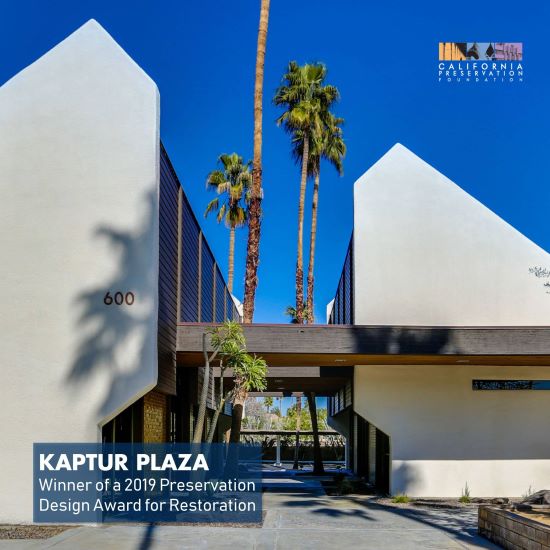
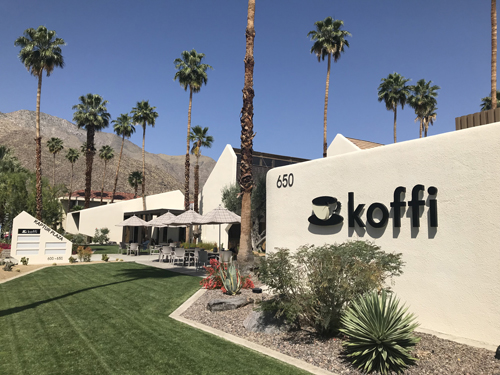
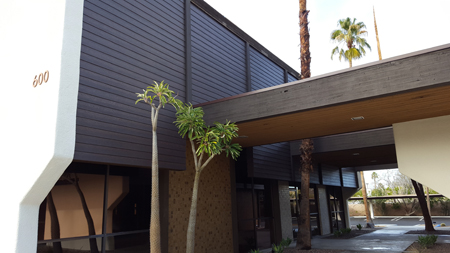
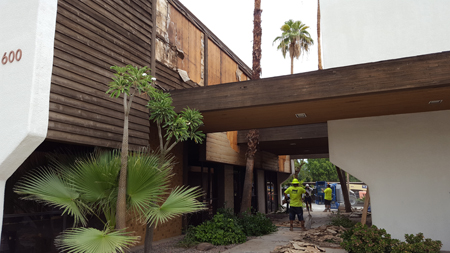
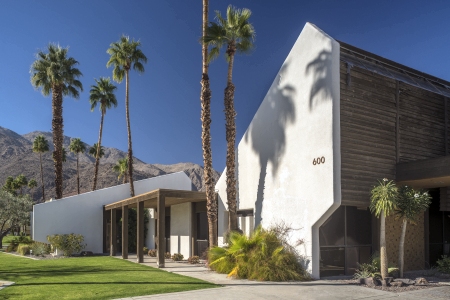
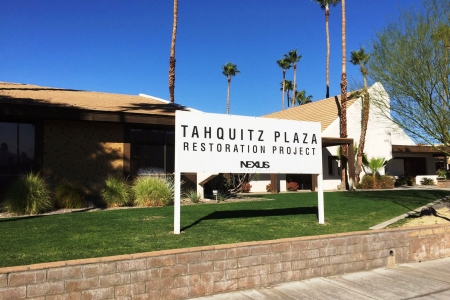
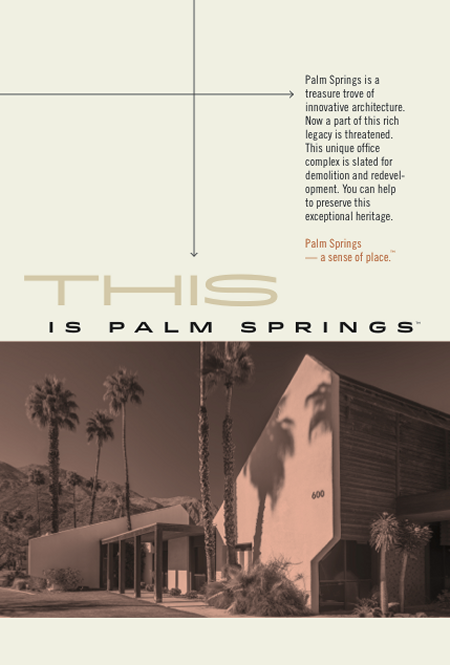
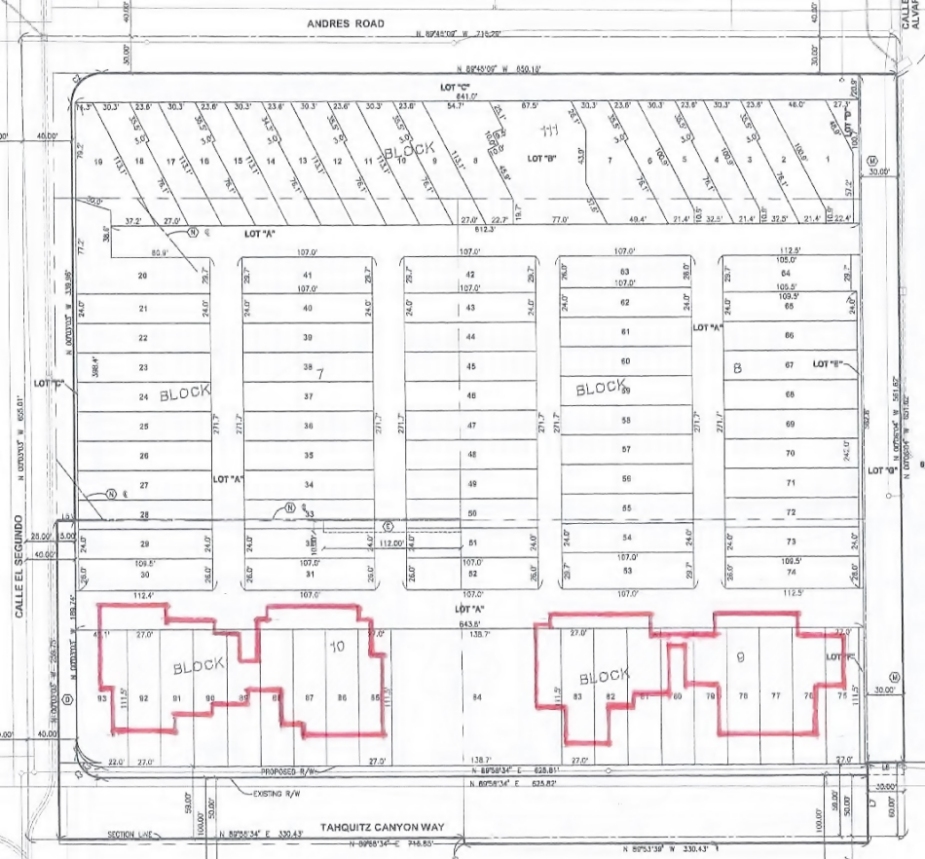
REFERENCES
IN THE MEDIA
March 11, 2019, Desert Sun (Tahquitz Plaza)
2018-2019, The Guide Annual Edition (Tahquitz Plaza)
February 17, 2016, Desert Sun (Tahquitz Plaza)
December 5, 2015, Desert Sun (Tahquitz Plaza)
December 3, 2015, Desert Sun (Tahquitz Plaza)
December 1, 2015, Desert Sun (Tahquitz Plaza)
November 2, 2015, Desert Sun (Tahquitz Plaza)
September 29, 2015, Desert Sun (Tahquitz Plaza)
September 8, 2015, Desert Sun (Tahquitz Plaza)
August 12, 2015, Desert Sun (Tahquitz Plaza)
August 11, 2015, Desert Sun (Tahquitz Plaza)
July 16, 2015, Desert Sun (Tahquitz Plaza)
June 29, 2015, Desert Sun (Tahquitz Plaza)
June 3, 2015, Desert Sun (Tahquitz Plaza)
June 2, 2015, Desert Sun (Tahquitz Plaza)
May 6, 2015, Desert Sun (Tahquitz Plaza)
April 18, 2015, Desert Sun (Tahquitz Plaza)
April 9, 2015, Desert Sun (Tahquitz Plaza)
March 26, 2015, Desert Sun (Tahquitz Plaza)
January 27, 2015, Desert Sun (Tahquitz Plaza)
January 13, 2015, Desert Sun (Tahquitz Plaza)